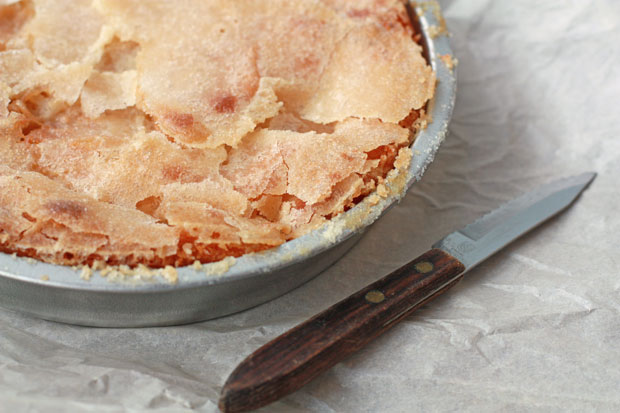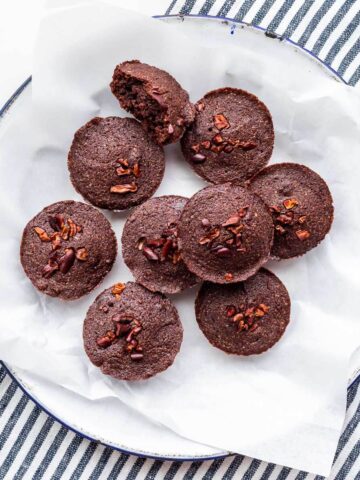If you want a recipe for apple yogurt cake, look no further! This is David Rocco's recipe and it's like a dense apple torte with a wonderful crispy sugar topping. Keep reading to find the recipe and my book review of David Rocco's book "Made in Italy" .

Oh, David Rocco.... I watch him on tv, usually in awe. He's a Canadian who lives part-time in Italy. He hangs out with his buddies in Rome, and cooks. He visits fun places like a chestnut farm, and eats and cooks among the trees. What a life! How do I sign up for this gig?
With all honesty, I don't really want to have a tv show. I'd rather have my perfect little bakery. In the meantime, I have David Rocco's latest book "Made in Italy" to review.
So far, I've tested a handful of recipes. What I love about this book: the simplicity. The recipes are quite simple and rustic. You don't need a fancy food processor, blender, mixer, etc. to make David Rocco's recipes. The photos in the book reflect this simplicity, depicting simple, traditional Italian dishes. There are no fancy plating techniques here: the pizzas aren't perfectly round and there are sometimes dribbles of sauce on the serving plate photographed. The dishes really look homemade.

What I don't love (i.e. me being picky): solids (like flour, sugar, etc.) are measured in cups/milliliters (mL). My inner chemist thinks that volumes are for liquids, weights are for solids. Unfortunately, I think Canadian publishing regulations dictate that solids be reported for cookbooks in cups/mL. This makes absolutely no sense to me, but those are the rules. Oh well.
My other issue is with the ingredient lists. For the dessert (dolci) section, I think it is important to specify to use unsalted butter and granulated sugar, for example. However, in this book, these ingredients are listed as butter and sugar, which is fine for the experienced bakers who know what type of butter and sugar to use, but for a novice, I think it's important to specify exactly what ingredients were used. These are really minor details though, and I'm definitely going to continue cooking with this book.

This apple yogurt cake is a dessert recipe adapted from David Rocco's "Made in Italy" (page 341). The recipe is really simple and can even be mixed together by hand (or with a hand mixer, as David Rocco recommends) if you don't have a stand mixer. The cake has a lovely moist texture and is full of apple slices. The original recipe said to bake the cake for 40 minutes, but mine took over an hour to bake. I love the crispy sugar topping that crackles as the cake cools and its crispy texture is a welcome sweet contrast to the soft, slightly tart apples. This is a great snacking cake and absolutely appropriate for the end of fall.
📖 Recipe

David Rocco's Apple Yogurt Cake
Ingredients
- 156 grams bleached all-purpose flour 150 grams
- 1.25 mL ground cinnamon
- 1.25 mL Diamond Crystal fine kosher salt
- 100 grams granulated sugar
- 200 grams unsalted butter melted, plus a little extra for buttering the pan
- 2 large egg(s)
- 125 mL yogurt (2 % fat)
- 2 Cortland apple(s) peeled, cored, and thinly sliced
- 15 mL finely grated lemon zest
- 75 grams granulated sugar for the topping
Instructions
- Preheat the oven to 350°F. Butter an 8-inch cake round.
- In a medium bowl, whisk together the flour, cinnamon, and salt.
- In the bowl of an electric mixer fitted with the paddle attachment, beat the ½ cup of sugar and the melted butter until it has lightened.
- Add the eggs, one at a time, beating between each addition and scraping down the bowl as needed.
- Reduce the mixer speed to low and add the flour mixture alternately with the yoghurt, beginning and ending with the flour.
- Stir in the sliced apples and the lemon zest, and pour the batter in the prepared pan.
- Sprinkle the ⅓ cup sugar evenly over the top of the cake.
- The original recipe suggests a baking time of 40 minutes, but I think it needs to bake for over one hour (until a tester inserted into the center (not through an apple if possible!) comes out clean.
- Let cool completely before serving.
Nutrition
Please note that I was sent this book by Harper Collins publishing, but my opinion is my own.






Lili says
La acabo de hacer, dejé enfriar un poco la manteca derretida mientras preparaba el resto de los ingredientes y luego la batí con el azúcar en máquina por 10 minutos y se aclaró bastante, luego fui agregando el resto de los ingrediente como indica la receta y la terminé con azúcar mascabo porque me gusta mucho, no me animé a reemplazar el azúcar granulada por mascabo en el interior de la receta porque temí que no se integrara bien, quizás la próxima vez lo haga. La tuve en el horno 55' mi horno es bastante fuerte y si lo bajo demasiado se apaga así que no tengo mucha opción.
Salió riquísima...!
claudia says
Até que enfim uma receita que só existia na minha idéia, mas não sabia como fazer.
Obrigada.
A D says
Hi. I just read through all of the comments...after putting the cake in the oven.Now I'm afraid I didnt mix the butter and sugar enough. Can you explain what it means to get it "light"? Thanks
Janice Lawandi says
Honestly, the first time I made this, I threw it together without thinking (no excessive beating of butter+sugar), and it did turn out, so I think you will be okay.
As for the lightening, basically we are supposed to beat enough so that the melted butter begins to cool and thicken, but in thickening, you will be able to get some "volume" out of it, meaning the mixture in the end will be lighter. The mixture at the beginning and end of beating will look quite different. And I think the more the mixture is "lightened" at this step, the less dense the final cake will be. I hope that makes sense.
Let me know how it turns out!
Eve says
Hi! thanks for the conversion in grams and mL 🙂